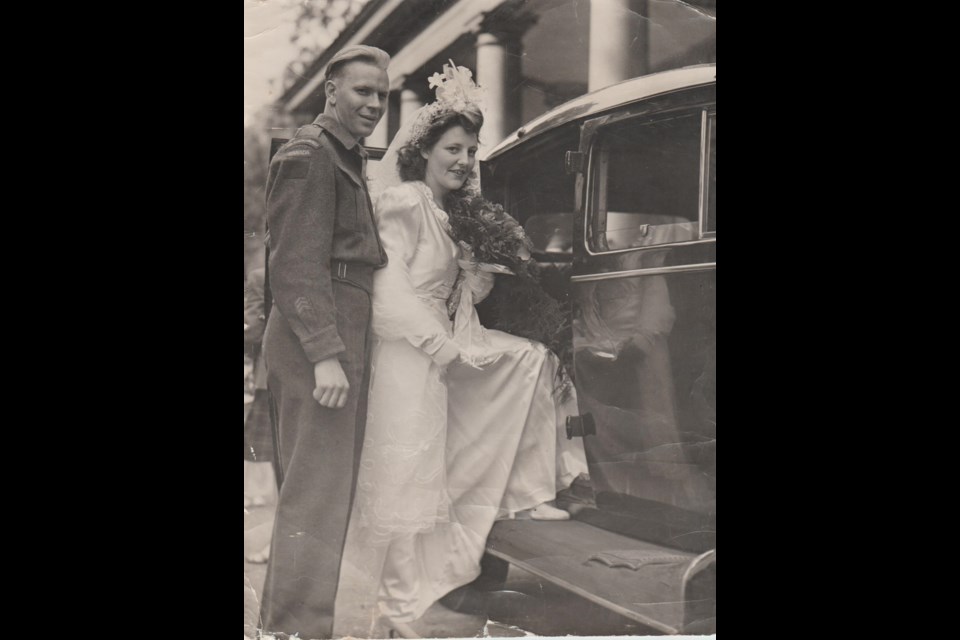It was a heady but challenging time, a few months after the end of World War II, when Londoner Doreen Kamis first set eyes on the man she’d marry. She was in nursing, just out of her teens.
“I was off duty and went for a dance at the Canadian army camp, what they called their dance hall. That’s where I met him,” she recalled of 22-year-old Canadian soldier John Anders-Christoffersen.
Within a year, Kamis became one of the 48,000 British war brides who made their way to an unknown life in Canada during and after WWII. Some 3,000 more came from the Netherlands, Belgium, Italy and France.
Another young war bride, Jeanne Marchais, from France’s Loire Valley, met Canadian soldier Max Pfannmuller in 1945. The next year the newlyweds made the long voyage to his family farm, near Mayerthorpe.
At a late 2022 presentation by the Edmonton branch of the Alberta Genealogical Society (AGS) on Alberta's war brides, Marchais’ daughter, Anna-Lynn Sanche, shared memories of her mother’s experiences. It included crossing the Atlantic from Southampton, and landing in Halifax before boarding trains for points west.
“My father was looking for his aunt,” explained Sanche on the circumstances of her parents’ meeting. “His mother was also a French woman who married a German man, and immigrated to Canada in 1905.”
Like many overseas newlyweds, their crossing was not together.
“Dad returned on the Ȋle de France in March, 1946,” said Sanche. “Mom came over on the Queen Mary in August.”
Early in the war, the Canadian government became aware of marriages between overseas servicemen and local women, but it wasn’t until final victory that plans to bring the newlyweds and their young families home could be fully realized. The Canadian Wives’ Bureau, with its first offices in London, arranged for their transport, and with the help of the Red Cross, assisted in the transition to Canadian life.
In Britain, many women of Kamis’ age had endured bombing raids, rationing and personal loss. Despite official army policy and sometimes their own families’ discouragement to meet and marry Canadian servicemen, young people often saw few good reasons not to.
Kamis married her young soldier. He returned to his family’s farm near Strathmore, AB, with Kamis following in December, enduring the ocean crossing and then a five-day train ride to her new home on the Alberta prairies.
For Jeanne Marchais, her Canadian experience was not an uncommon feature of the war brides’ new life. Canada in the 1940s was largely rural, many homes having no electricity or indoor plumbing.
“Their house was an uninsulated granary, without any windows, that Dad got from the government for his army service,” said Sanche. “They were more than two kilometres from the nearest neighbour on an old dirt path that turned into mud when it rained.”
“It's that spirit and tenacity that made these ladies brave enough to cross the big pond to a new land and start all over again. For many of them it was more than rustic--it was primitive,” she said.
European war brides brought their culture with them which, naturally, influenced culture in Canada. Historian Pierre Berton has called them “one of the great and unheralded mass movements in recent history”, with organizations like AGS helping to keep their legacy alive.
For a few, the situation didn’t turn out well and they returned to their families in Europe. But for the most part, Canada’s war brides were welcomed by their new families and communities.
“I’d never been on a farm. My in-laws were very, very good to me,” said Kamis, a founding member of Alberta War Brides Association which launched in the 1950s for fellow war brides in their new homeland.
“It was important to us,” she said. “We had each other's phone numbers, and got together.”
Those connections endure today, carried forward by Anna-Lynn Sanche and other adult children of war brides.
“I’ll be 96 in February. There are not many of us left,” said Kamis. “It’s our children who are now carrying on the legacy.”
Lisa Mackenzie, programs coordinator with AGS Edmonton branch, describes it this way. "Their collective personality trait was a boundless spirit, big enough to match the prairie sky."
A war brides' reunion is scheduled for Sept. 15-17, 2023 in Regina, Sask. For more information, see abgenealogy.ca. There's more on Alberta and Canadian war brides at canadianwarbrides.com.



